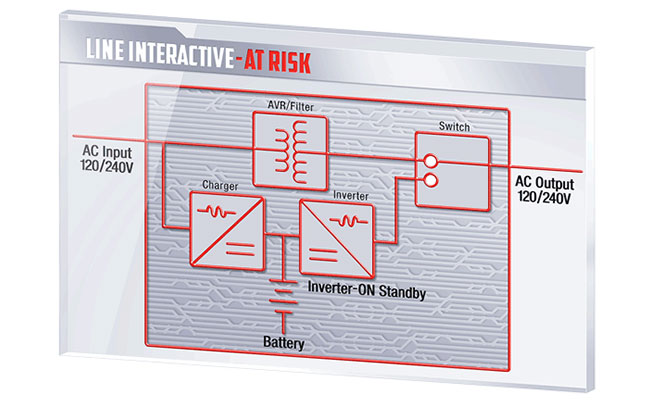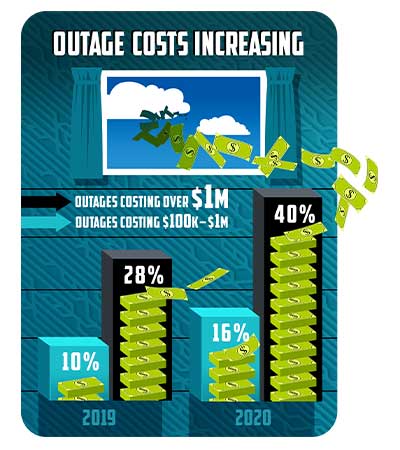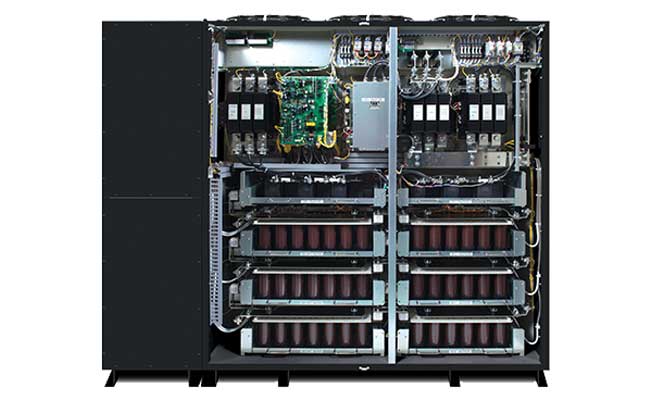What is a Static UPS?
A static UPS system provides instantaneous backup power from a battery when the utility power fails. It can also condition the power so that other anomalies (sags, surges, harmonics, switching transients, frequency variations) on the utility line do not damage equipment.
However, not all static UPS are created equal, and some may not provide power conditioning.
What is a Static UPS?
A static UPS system provides instantaneous backup power from a battery when the utility power fails. It can also condition the power so that other anomalies (sags, surges, harmonics, switching transients, frequency variations) on the utility line do not damage equipment.
However, not all static UPS are created equal, and some may not provide power conditioning.
The Difference Between Offline (Line Interactive) & Online Double conversion static UPS
There are two main types of static UPS systems — offline (or line interactive) and online, double conversion.
Offline (line interactive) UPS systems run on utility power until the UPS senses a problem and then reverts to the alternative power source (typically batteries). These systems have an inverter for operation on batteries and some even have a power interface that can regulate the voltage even when not on battery.
The downside is that these systems are not protecting the critical equipment continuously, but rather switch to conditioning mode.


Online double conversion UPS systems take the utility power and deconstruct the alternating current (AC) waveform to a direct current (DC) waveform using the converter/rectifier. The UPS system then reconstructs the AC waveform using the inverter to provide the critical load with a conditioned, pure AC sine waveform free of any distortion, sags, surges, and other imperfections that can damage sensitive electronic equipment.
On the DC side, operators can introduce batteries, flywheels, or supercapacitors to the system to provide power when the utility is unavailable or out of tolerance. The online double conversion UPS system provides constant voltage and constant frequency to critical loads. They are the most reliable topology since they protect the critical equipment they serve 24 hours a day, seven days a week.
Advancements in static UPS technology
UPS technology has evolved over the years in order to increase efficiency, reliability, and generator compatibility. Below are several recent advancements in UPS design that have helped create a more reliable and efficient UPS.
| Insulated Gate Bipolar Transistors (IGBTs) |
IGBTs are an advancement in both UPS converter and inverter topology. For converters, IGBTs allow for the reduction of large input harmonic filters. Smaller filters reduces input current harmonics and moves toward a unity power factor that eliminates generator compatibility issues.
So, oversized generators are no longer necessary to compensate for leading power factor. For inverters, IGBTs turn on and off quickly for higher performance and a more accurate AC waveform. They reduce harmonic distortion and the need for an isolation transformer – improving overall UPS system efficiency.
| Three Level Topology |
Three-level topology, while having more IGBTs in the power path (thus, increasing conduction loses) are only switched to half of the typical DC voltage. This lowers voltage stress and switching losses on the IGBT increasing UPS system reliability.
The increase in conduction losses combined with the lower switching losses creates a net overall efficiency gain over the two-level topology. Three level topology also paves the way for further efficiencies and green-powered UPS.
| Transformerless Technology |
Transformerless technology, made possible by the use of IGBTs that provided advanced, reliable fault detection, created a higher-efficiency UPS.
Transformerless systems also remove the single point-of-failure and reduce the weight and footprint of modern UPS models. Since there is no transformer, there is no need for transformer impedance surge suppression.
| Virtual Neutral |
The virtual neutral gives a neutral-to-ground reference point by connecting the common points on the input and output filters to ground through a capacitor. It’s better at sensing faults and alarming the UPS system. A phase-to-ground fault at the load when the upstream transformer is grounded will produce high amounts of current in the inverter phases that the UPS system will detect through its control logic.
| UPS Control |
UPS Control of the IGBT power devices is critical to optimum performance characteristics for reliability and efficiency as well as functionality. Top control systems have a digital signal process (DSP) for measuring the voltages throughout the system and an application specific integrated circuit (ASIC) field programmable gate array (FPGA) to measure the currents throughout the system. It makes a multi-module system (MMS) cross current control loop easier to regulate.
Efficient UPS design
Since the isolation transformers have been eliminated, the large harmonic mitigating filters have been removed, and IGBTs are used with the advanced control system in a three-level topology; the UPS system now has a smaller footprint, is lighter, and has significantly increased efficiencies even at low loads.
These benefits equate to space savings, freight savings, lower emissions of heat, less cooling demand, energy savings, lower noise, and interference, which collectively, create a green-oriented, eco-friendly UPS system. Modern UPS can also leverage more sustainable power sources, such as lithium ion batteries.
Oops! It looks like the CTA's heading, copy, or button is missing. Please check your component settings before publishing.
Choose Mitsubishi Electric's Online Double Conversion UPS
When selecting a static UPS, choose one with true online double conversion, preferably with three-level converter and inverter topology as well as an insulated gate bipolar transistor DC chopper circuit with high switching frequency. Opt for a transformerless UPS when possible and review the controls to ensure they support your chosen UPS topology. Choosing the right static UPS can help you find efficiencies, while gaining reliable backup power for the life of your system.

